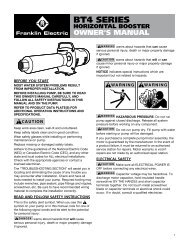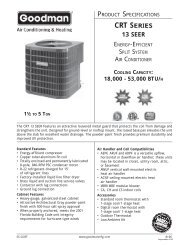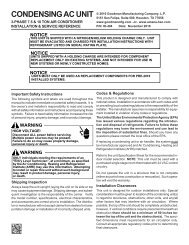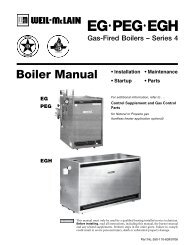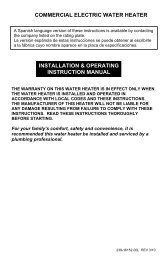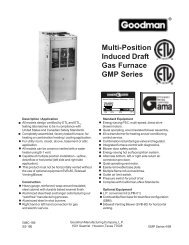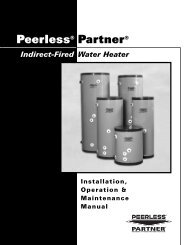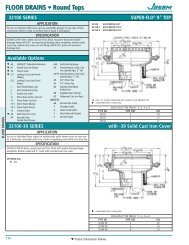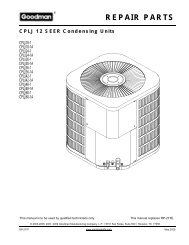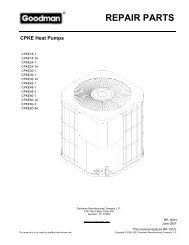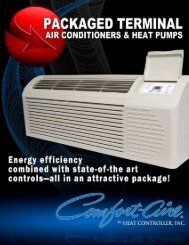7.5 TON - 12.5 TON PACKAGE GAS SERIES CPG SERIES - Goodman
7.5 TON - 12.5 TON PACKAGE GAS SERIES CPG SERIES - Goodman
7.5 TON - 12.5 TON PACKAGE GAS SERIES CPG SERIES - Goodman
You also want an ePaper? Increase the reach of your titles
YUMPU automatically turns print PDFs into web optimized ePapers that Google loves.
CLEAN OUTSIDE COIL (QUALIFIED SERVICER ONLY)<br />
The coil with the outside air flowing over it should be inspected<br />
annually and cleaned as frequently as necessary to keep the<br />
finned areas free of lint, hair and debris.<br />
Flames should be stable, soft and blue (dust may cause orange<br />
tips but must not be yellow). The flames must extend<br />
directly outward from the burner without curling, floating or<br />
lifting off.<br />
CONDENSER, EVAPORATOR, AND INDUCED DRAFT MOTORS<br />
Bearings on the air circulating blower motor, condenser motor<br />
and the combustion fan motor are permanently lubricated.<br />
No additional oiling is required.<br />
FLAME SENSOR (QUALIFIED SERVICER ONLY)<br />
A drop in the flame current can be caused by a nearly invisible<br />
coating on the flame sensor. This coating, created by the<br />
fuel or combustion air supply, can be removed by carefully<br />
cleaning the flame sensor with steel wool.<br />
NOTE: After cleaning, the microamp signal should be stable<br />
and in the range of 4 - 6 microamps DC.<br />
FLUE PASSAGES (QUALIFIED SERVICER ONLY)<br />
At the start of each heating season, inspect and, if necessary,<br />
clean the unit flue passage.<br />
LUBRICATION<br />
The fan shaft bearings, the 1 to 2 HP supply fan motors the<br />
condenser fan motors and compressors are permanently lubricated.<br />
INSPECTION & CLEANING<br />
All flue product carrying areas of the furnace, its vent system,<br />
and main burners should be examined by a qualified<br />
service agency before the start of each heating season. This<br />
examination is necessary for continued safe operation. Particular<br />
attention should be given to deterioration from corrosion<br />
or other sources. This examination is accomplished in<br />
the following manner.<br />
1. Disconnect power to the unit and remove furnace<br />
section access panel.<br />
2. Remove burner assembly:<br />
a. Disconnect the three wires from the gas valve after<br />
noting which wires are connected to each terminal.<br />
b. Disconnect wires from the flame rod and ignition<br />
electrode.<br />
c. Disconnect the gas piping at the union.<br />
d. The entire burner assembly can now be removed<br />
from the unit.<br />
BURNER FLAME<br />
WARNING<br />
TO AVOID PERSONAL INJURY OR DEATH DUE TO ELECTRIC SHOCK, DO<br />
NOT REMOVE ANY INTERNAL COMPARTMENT COVERS OR ATTEMPT ANY<br />
ADJUSTMENT. CONTACT A QUALIFIED SERVICER AT ONCE IF AN<br />
ABNORMAL FLAME SHOULD DEVELOP.<br />
At least once a year, prior to or during the heating season,<br />
make a visual check of the burner flames.<br />
NOTE: This will involve removing and reinstalling the heat<br />
exchanger door on the unit, which is held by two screws. If<br />
you are uncertain about your ability to do this, contact a<br />
qualified servicer.<br />
If a strong wind is blowing, it may alter the airflow pattern<br />
within the unit enough that an inspection of the burner flames<br />
is not possible.<br />
FUNCTIONAL PARTS<br />
Refer to the unit Parts Catalog for a list of functional parts.<br />
Parts are available from your distributor.<br />
NOTE: Use all screws that were removed; they are<br />
necessary for safe and proper operation of the unit.<br />
3. Inspect and periodically clean the vent outlet (bird<br />
screen) on the access panel.<br />
NOTE: Periodic observation of the flame and a log of C0 2<br />
measurements are recommended. This will aid in determining<br />
whether the furnace is operating efficiently or if the furnace<br />
requires cleaning.<br />
23



